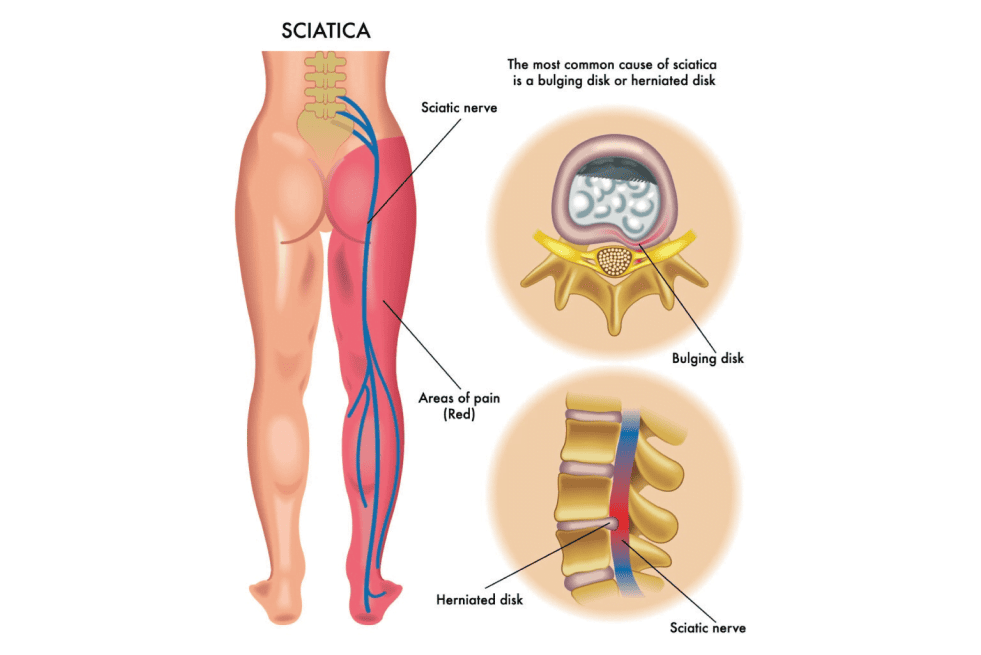
Lumbar Radiculopathy
- Home
- Conditions
- Back & Spine Conditions
- Lumbar Radiculopathy
What is Sciatica?
Sciatica refers to pain that radiates along the path of the sciatic nerve, which branches from your lower back through your hips and buttocks and down each leg. Typically, sciatica affects only one side of your body.
Treatment for Lumbar Radiculopathy (Sciatica)
Understanding Sciatica
Sciatica refers to pain that radiates along the path of the sciatic nerve, which branches from your lower back through your hips and buttocks and down each leg. Typically, sciatica affects only one side of your body.
Sciatica is a common condition, affecting up to 40% of people at some point in their lives. It is most prevalent in individuals aged 30 to 50 and can significantly impact the quality of life if not properly managed.
Understanding sciatica is crucial for early intervention and effective treatment. Increased awareness can help individuals recognize symptoms early and seek appropriate medical care, reducing the risk of chronic pain and disability.
Causes of Sciatica
Sciatica refers to pain that radiates along the path of the sciatic nerve, which branches from your lower back through your hips and buttocks and down each leg. Typically, sciatica affects only one side of your body.
Sciatica is a common condition, affecting up to 40% of people at some point in their lives. It is most prevalent in individuals aged 30 to 50 and can significantly impact the quality of life if not properly managed.
Understanding sciatica is crucial for early intervention and effective treatment. Increased awareness can help individuals recognize symptoms early and seek appropriate medical care, reducing the risk of chronic pain and disability.
Herniated Disc
A herniated disc occurs when the soft center of a spinal disc pushes through a crack in the tougher exterior casing. This herniation can press on the sciatic nerve, causing pain.
Spinal Stenosis
Spinal stenosis is the narrowing of the spaces within your spine, which can put pressure on the nerves that travel through the spine, including the sciatic nerve.
Piriformis Syndrome
The piriformis muscle, located in the buttocks, can sometimes cramp and press the sciatic nerve, leading to pain.
Trauma or Injury
Injuries such as pelvic fractures or a direct blow to the buttocks can lead to sciatica.
Other Causes
In rare cases, conditions like tumors or infections can compress the sciatic nerve causing sciatica.
Symptoms of Sciatica
Pain Characteristics
Sciatic pain can vary widely. It might feel like a mild ache, a sharp burning sensation, or intense pain. Some people also experience jolting or electric shock-like pain.
Common Areas Affected
Pain usually radiates from your lower (lumbar) spine to your buttock and down the back of your leg.
Associated Symptoms
Symptoms may include numbness, tingling, or muscle weakness along the nerve pathway. Some people also experience a loss of bladder or bowel control, which requires immediate medical attention.

Risk Factors
Several factors can increase the risk of developing sciatica, such as:
- Age-related changes in the spine.
- Occupations that involve heavy lifting or prolonged sitting.
- Sedentary lifestyle.
- Diabetes can increase the risk of nerve damage.
- Obesity can place additional strain on the spine.
Diagnosis of Sciatica
Diagnosing sciatica typically involves a combination of medical history, physical examination, and imaging tests. During the physical exam, a doctor may check for:
- Muscle strength and reflexes.
- Ability to lift legs straight while lying down.
- Sensation in the legs and feet.
- Imaging tests like X-rays, MRI, or CT scans can help identify the underlying cause of sciatica by revealing herniated discs, bone spurs, or spinal stenosis.
Prevention of Sciatica
Exercise and Physical Activity
Regular exercise strengthens the muscles supporting your spine and improves flexibility.
Proper Lifting Techniques
Use your legs, not your back, to lift heavy objects.
Ergonomic Adjustments
Ensure that your workstation supports a healthy posture.
Weight Management
Maintaining a healthy weight reduces the stress on your spine.
Treatment Options for Sciatica
- Rest and Activity Modification: Short-term rest followed by a gradual return to activity.
- Physical Therapy: Exercises to strengthen muscles and improve flexibility.
- Medications: Over-the-counter pain relievers and prescription medications for severe pain.
- Hot and Cold Therapy: Applying heat or cold packs to reduce inflammation and pain.
- Transforaminal Epidural Injections (TFEIs): TFEIs are commonly used to alleviate radiculopathy caused by nerve compression due to herniated discs or spinal stenosis.
- Epidural Steroid Injections (ESIs): In cases of severe or persistent pain, an ESI may be recommended. This procedure involves injecting a corticosteroid medication directly into the affected area to reduce inflammation and alleviate pain.
- Platelet-rich plasma and Prolotherapy: It can also be undertaken in cases of sciatica due to degenerative disc disease to treat the arthritic facet joints and strengthen the ligament bone interface.
- Surgical Intervention: If conservative treatments do not provide relief or the underlying condition is severe, surgery may be considered. Common surgical options include discectomy (removal of a herniated disc). Microdiscectomy and Endoscopic discectomy are two common approaches for a majority of surgical cases.
at Alleviate Pain Clinic
- Purpose: Reduce inflammation and alleviate pain.
- Procedure: Injection of corticosteroids into the epidural space around the spinal nerves.
- Benefits: Temporary pain relief, reduced inflammation, facilitates physical therapy.
- Purpose: Target specific nerve roots causing sciatic pain.
- Procedure: Injection of corticosteroids and anesthetics into the foraminal space where the nerve exits the spine.
- Benefits: Targeted pain relief, reduced inflammation, improved mobility.
Endoscopic Decompression
- Purpose: Remove the source of nerve compression.
- Procedure: Minimally invasive surgery using an endoscope to remove herniated disc material or bone spurs.
- Benefits: High success rate, shorter recovery time, less postoperative pain, long-term relief.
Combined Approach
- Conservative Treatments: Physical therapy to improve strength, flexibility, and mobility.
- When to Consider Invasive Treatments: Persistent or worsening symptoms despite conservative management.
- Goals: Alleviate pain, restore function, prevent further injury.
At Alleviate Pain Clinic, we offer a comprehensive treatment plan for sciatica, incorporating epidural injections, transforaminal blocks, and endoscopic decompression in failed conservative management, coupled with physiotherapy. Contact us to develop a personalized approach to manage your sciatica and improve your quality of life.
FAQ'S
Often, sciatica affects one side of the body, not both. The sciatica symptoms experienced vary depending on the location of the nerve compression. Doctors help to locate the origin of the nerve compression in order to properly treat sciatica pain.The sciatic nerve is the largest nerve in our bodies traveling down the lower back, hip, buttocks and the back of the leg down to the foot.
Due to the location of the sciatic nerve, certain activities such as prolonged sitting and quick movements may increase sciatica pain.
For some individuals Sciatica pain may be bearable yet irritating, while for others it may be severe and debilitating. Sciatica causes pain, a burning sensation, numbness, or tingling radiating from the lower back and upper buttock down the back of the thigh to the back of the leg. The result is lumbar pain, buttock pain, hip pain, and leg pain. Sometimes the sciatic pain radiates around the hip or buttock to feel like hip pain.
- Pain on one side of the buttock or in one leg that becomes worse when sitting
- Burning or tingling down the leg
- Weakness, numbness, or difficulty in moving the leg or foot
- A constant pain on one side of the posterior
- A sharp pain that may make it difficult to stand or walk
At Alleviate, our doctors are highly experienced in providing non surgical sciatica treatments over the course of a few weeks to a few months depending on the severity of your sciatic pain. Our group of doctors includes Spine Specialist and Pain Management Specialists. Fortunately, sciatic nerve pain can be relieved by combining physical therapy, muscle strengthening, manual therapy and other specialized techniques. In severe cases, sciatica may require surgery due to severe nerve pain.
Our Sciatica doctors at Alleviate will consult with you, review your health history and perform a physical exam. They may also request imaging to locate the origin of your sciatica pain to better treat you. Our goal is to treat your sciatica pain using interventional treatments to avoid sciatica surgery. Sciatica diagnosis and testing includes:
- physical examination
- Imaging modalities like MRI
If you are experiencing any of the sciatica symptoms above and think you may have Sciatica, consult immediately with a doctor. By diagnosing the area and degree of pain, specialists can provide the right level of treatment for your sciatica.
At Alleviate, our team of doctors includes Spine Specialists and Pain managemennt specialists. There are multiple non-surgical Sciatica treatment options available at Alleviate.
Yes, mild sciatica often resolves with self-care measures and time. However, severe or persistent cases may require medical treatment.
Recovery time varies. Mild cases may improve in a few weeks, while more severe cases could take several months.
Sciatica is not usually permanent, but recurrent episodes can occur if the underlying cause is not addressed.
Video Spotlight
Blog
Surgery-Free Solutions
Expert Tips for Pain Management
Testimonials
Words From Our Patients
The treatment was very good and the doctor Faraz Ahmed was very kind to the patient and explained clearly the procedure of knee bilateral ha & botox And we were advised to do physiotherapy. We are very much satisfied. We would recommend this alleviate pain clinic. Thank you
Got treatment of Botox and HA for right knee arthritis a month ago and finding good relief from pain. Was treated by Dr Swagtesh Bastia who explained very well about the injections and the treatment was painless. The front desk staff were very kind and very helpful and physiotherapy was also done expertly, overall good experience
Alleviate Pain Management clinic has been a godsend for my mom's knee pain. She has been treated by Dr. Wiquar Ahmed. The attentive staff provided personalised care, and after her treatment, she's feeling remarkably better. Thank you for giving my mom the relief she deserves!
The clinic is super clean with a great OT and most importantly all the staff here are very helpful and considerate. My gratitude to Dr Roshan, the nurses, and support staff - they were always available to assist with any issues post procedure and they even made an extra effort to make a home visit for a follow up check-up. This team here is the perfect example of healing and care with a human touch. Thank you!!!!!
My wife had knee pain I have visited alleviate pain and consulted doc santhoshi now she is able to walk pain free and can do her daily activity than before.the physiotherapist here Dr akhila also helped her with few exercises and the staff here Abdul explained all the procedures well . Thank you PPL can visit here for pain relief






